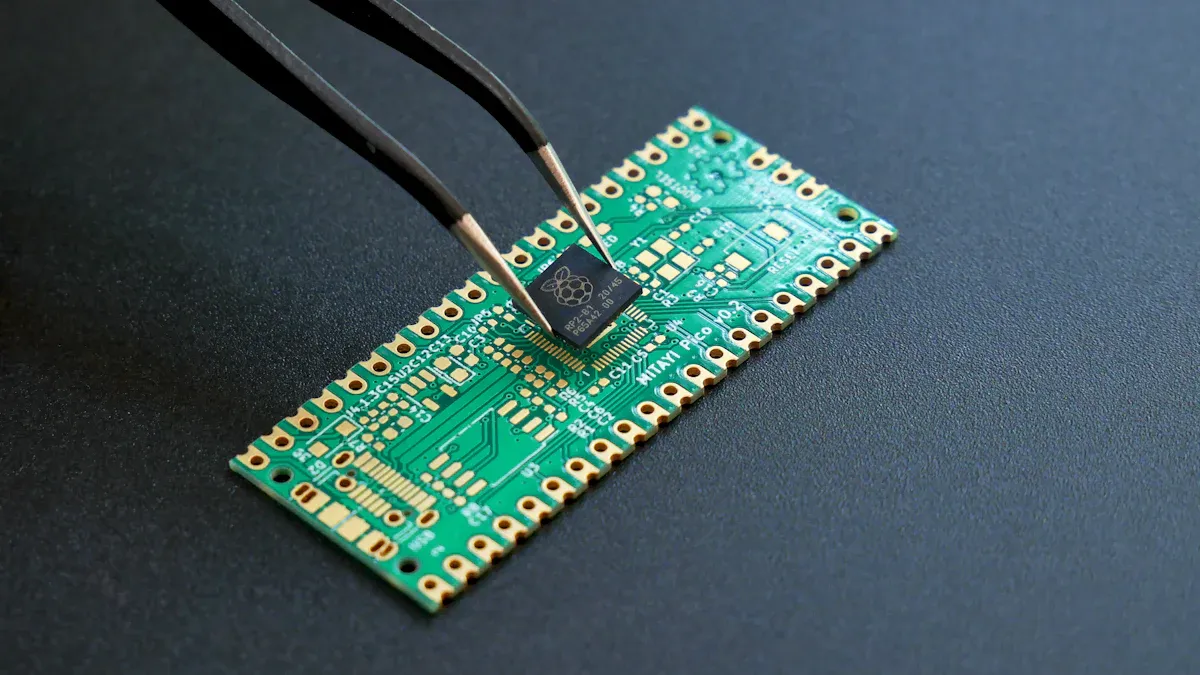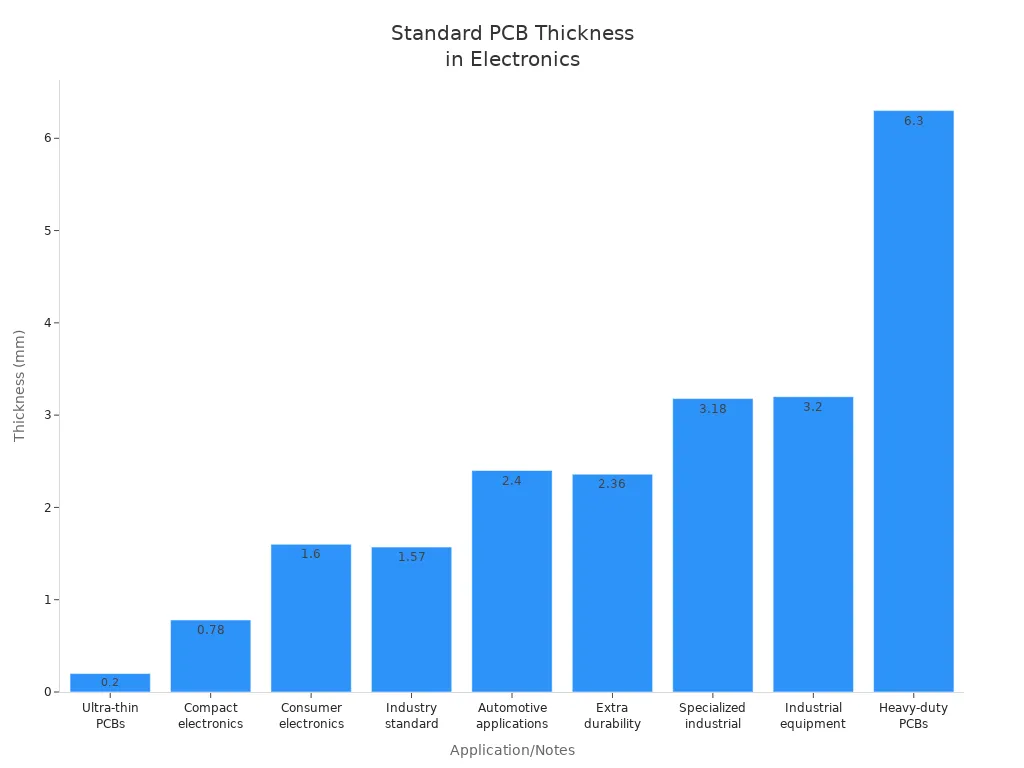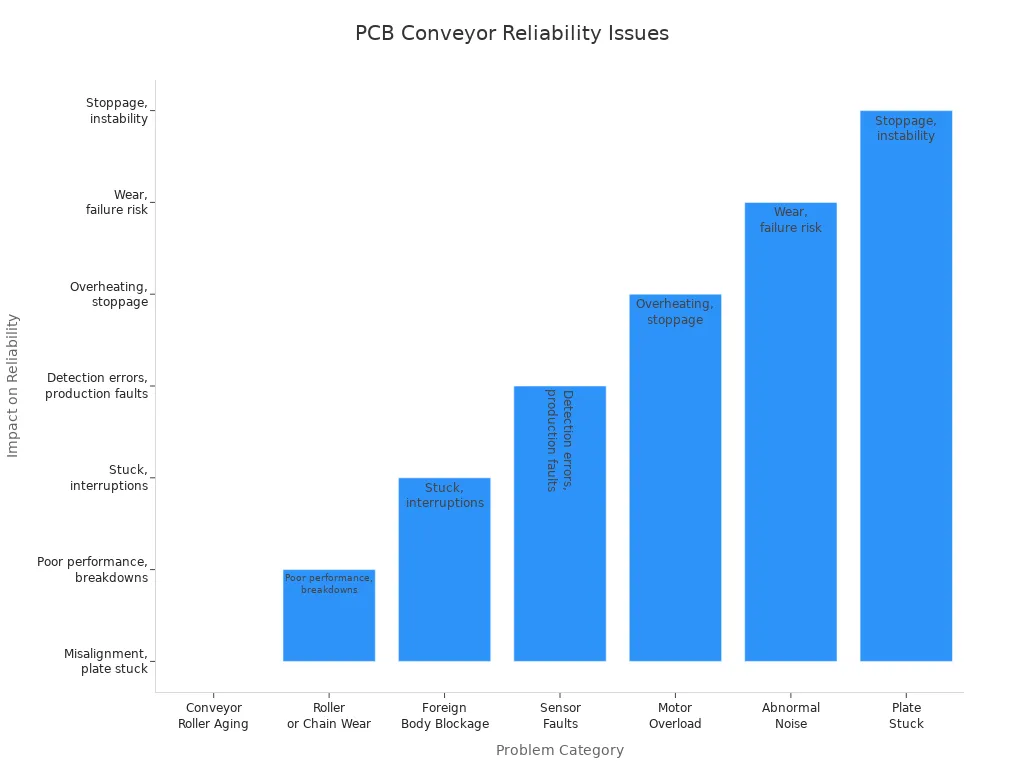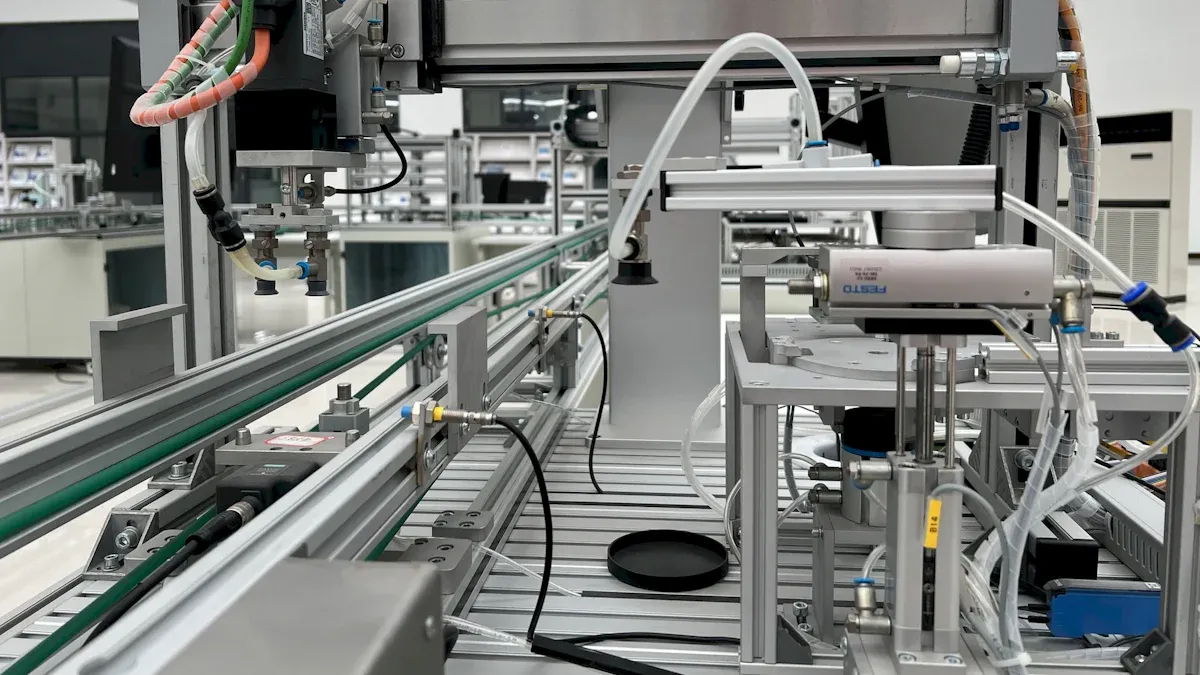
The most critical factor when companies choose PCB Conveyor systems lies in matching conveyor type and features to the unique needs of the production line. A well-matched conveyor offers precise positioning for accurate docking, smooth PCB transmission, and strong stability that reduces errors. High adaptability and flexibility allow the system to fit various production setups, while efficient operation boosts throughput. Reliable conveyors also support better quality control and withstand harsh conditions like high temperatures or corrosion. Poor conveyor choices often lead to increased errors, wasted resources, and production delays. Companies that focus on efficiency, reliability, and long-term value gain a clear advantage in electronics manufacturing.
Key Takeaways
-
Match conveyor type and features to your PCB size, weight, and production speed for smooth handling and fewer errors.
-
Plan your production line layout carefully to fit conveyors without crowding and allow easy maintenance access.
-
Choose conveyors with adjustable speed, automation, and ESD protection to improve efficiency, reduce defects, and protect components.
-
Regular maintenance, like cleaning and part replacement, prevents breakdowns and keeps your conveyor reliable.
-
Use a clear checklist and compare conveyor options to ensure compatibility with existing equipment and support future growth.
Choose PCB Conveyor: Assess Your Needs

PCB Size and Weight
When companies begin to choose PCB conveyor systems, they must first consider the size and weight of the printed circuit boards. PCB thickness and material type vary widely across industries. For example, consumer electronics often use boards between 1.0 mm and 1.6 mm thick, while automotive and industrial applications require thicker boards for durability and heat management. The following table shows standard PCB thicknesses and their typical uses:
|
PCB Thickness (mm) |
PCB Thickness (inches) |
Typical Application/Notes |
|---|---|---|
|
0.2 |
0.007 |
Ultra-thin PCBs |
|
1.0 – 1.6 |
0.039 – 0.063 |
Consumer electronics |
|
1.57 |
0.062 |
Industry standard |
|
2.0 – 2.4 |
0.079 – 0.094 |
Automotive applications |
|
3.2 |
0.126 |
Industrial equipment |
|
6.3 |
0.250 |
Heavy-duty PCBs |
Tip: Thicker PCBs provide more mechanical strength and better heat dissipation, but thinner boards help reduce device weight and size.
PCB weight depends on thickness, material, and copper content. In high-volume production, some conveyors must handle boards up to 742×810 mm and weighing as much as 10 kg. Conveyor type selection depends on these factors. Belt conveyors suit a wide range of sizes and shapes, while roller and chain conveyors work better for larger, heavier boards. Overhead conveyors help save space and protect PCBs from damage.
|
Conveyor Type |
Suitability for PCB Size and Weight |
Key Advantages |
|---|---|---|
|
Belt Conveyor |
Handles a wide range of PCB sizes and shapes |
Smooth motion, easy maintenance, and cost-effective |
|
Roller Conveyor |
Better for larger and heavier PCBs |
Gentle handling, reduced friction, easy maintenance |
|
Chain Conveyor |
Suitable for heavy PCBs requiring high load capacity |
Durable, customizable, and transports over long distances |
|
Overhead Conveyor |
Efficient for vertical transport and space saving |
Reduces damage risk, customizable track configurations |

When companies choose PCB conveyor systems, matching conveyor features to board size and weight ensures smooth handling and prevents damage. This step supports production efficiency and quality.
Throughput and Speed
Production lines must move quickly to meet output targets. Conveyor speed controls how fast PCBs travel through assembly machines. A higher throughput rate increases the number of boards processed per hour. The following table highlights how conveyor speed affects efficiency:
|
Factor |
Effect on PCB Assembly Efficiency |
|---|---|
|
Throughput Rate |
Conveyor speed directly controls how fast PCBs move through SMT machines; faster conveyors increase output, slower ones reduce it. |
|
Component Placement Accuracy |
Proper conveyor speed and design ensure PCBs are aligned correctly, preventing defects and improving quality. |
|
PCB Warpage |
Well-designed conveyors minimize mechanical stress and temperature-induced warpage, preserving PCB integrity. |
|
Maintenance Requirements |
Efficient conveyors require less frequent repairs, reducing downtime and supporting continuous production. |
Note: Companies should choose PCB conveyor systems with adjustable speed settings to match the pace of their pick-and-place machines, reflow ovens, and inspection stations.
Selecting the right conveyor speed helps maintain cycle time and prevents bottlenecks. If the conveyor moves too slowly, production falls behind. If it moves too quickly, boards may misalign or suffer damage. Companies must balance speed with accuracy and reliability.
Line Layout and Space
Space planning plays a key role when companies choose PCB conveyor systems. Production lines often have limited room, so conveyors must fit within the available area without crowding other equipment. The minimum and recommended space requirements for SMT lines include:
|
Requirement Aspect |
|
|---|---|
|
Transfer side width |
Minimum 5.0 mm |
|
Components/solder joints on the transfer side |
None allowed on front and back edges |
|
Non-transfer side clearance |
Recommended 2.5 mm component-free area |
|
Transmission edge size |
Generally 3.5 mm or more, depending on equipment (stencil printer, SMT machine, reflow oven) |
Alert: Insufficient space can lead to installation problems, maintenance difficulties, and increased risk of PCB damage.
Companies should map out their production line layout before they choose PCB conveyor systems. They must consider the footprint of each conveyor, the path of PCB travel, and the need for access during maintenance. Overhead conveyors or modular designs can help maximize space and improve workflow.
By carefully assessing PCB size and weight, throughput and speed, and line layout and space, companies can choose PCB conveyor systems that match their production needs. This approach leads to higher efficiency, better product quality, and long-term value.
Key Factors in Selection
Conveyor Types
Manufacturers must evaluate conveyor types when they choose PCB conveyor systems. Each type offers unique advantages and limitations for electronics production. Belt conveyors provide cost-effective and flexible transport for many PCB sizes and shapes. Slat chain conveyors deliver a stable and precise platform, making them ideal for delicate or heavy PCBs. Inspection conveyors include lighting and magnification, which help operators detect defects and improve quality control. Turn conveyors change the direction of PCB flow, supporting complex line layouts. Link conveyors synchronize transitions between production stages, while buffer conveyors temporarily store PCBs to prevent bottlenecks.
|
Conveyor Type |
Advantages |
Disadvantages / Notes |
|---|---|---|
|
Belt Conveyors |
Cost-effective, flexible, adaptable to various PCB sizes and shapes, and integrates with machines. |
It may be less stable for delicate or heavy PCBs. |
|
Slat Chain Conveyors |
Stable and precise platform, ideal for delicate or irregular PCBs, handles heavy loads, and resists contamination. |
More complex and costly than belt conveyors. |
|
Inspection Conveyors |
Equipped with lighting, magnification, and inspection stations for defect detection. |
Specialized use may add cost and complexity. |
|
Turn Conveyors |
Facilitate directional changes in PCB flow, essential for complex layouts. |
Adds mechanical complexity to the line. |
|
Link Conveyors |
Provide precision and synchronization for smooth transitions between production stages. |
Typically used in precision-critical environments. |
|
Buffer Conveyors |
Temporarily store PCBs to manage flow and prevent bottlenecks, smoothing operations. |
Requires space and control to manage buffering effectively. |
Tip: Companies should match conveyor type to their specific production needs. This step ensures smooth PCB handling and supports efficient workflow.
Adjustability and Automation
Adjustability and automation play a major role in modern PCB conveyor systems. Adjustable speed and width settings allow conveyors to handle different PCB sizes and maintain alignment. Modular designs enable easy integration with inspection, pick-and-place, and soldering machines. Automation reduces manual labor by automating PCB loading and unloading, which minimizes errors and lowers labor costs. Automated systems can process hundreds of boards per hour, increasing production speed and throughput. Precise placement and alignment reduce defects and rework, further decreasing labor expenses.
-
Automated PCB loading and unloading systems minimize human intervention.
-
These systems increase production capacity and reduce labor costs.
-
Automation ensures precise placement and alignment, reducing defects.
-
Modular designs allow manufacturers to scale and adapt to changing production demands.
A smartphone manufacturer increased production capacity from 10,000 to 85,000 units per day after implementing full automation. Labor costs dropped by 78% per unit, and defect rates decreased significantly. Automation also enabled handling of multiple product variants with improved first-pass yield.
Note: When companies choose PCB conveyor systems, they should consider automation features that streamline workflows and reduce downtime.
ESD and Safety
Electrostatic discharge (ESD) protection is essential in PCB conveyor design. Modern conveyors use ESD-safe materials for belts to prevent and dissipate electrostatic charges. Compliance with IEC 61340-5-1 limits charge accumulation to under 100 V, protecting sensitive components. Conductive elements such as stainless steel plates and ESD-safe timing belt guide strips ground static charges effectively. Conveyor belts avoid charge buildup even under friction and movement, which can generate thousands of volts. Regular ESD audits ensure belts meet safety standards.
-
ESD-safe conveyor belts have low-friction surfaces and come in various widths and types.
-
Conductive conveyor belts are critical in ESD Protected Areas (EPA).
-
Regular audits and compliance with standards protect electronic components during transport.
Safety certifications vary by region and industry. ISO 9001 is a global standard for quality management. CE marking is required in Europe, while OSHA compliance is mandatory in the United States. ANSI and ASME provide detailed safety codes for conveyor systems. Emergency stop systems must be fail-safe and require a reset before restarting. Conveyor safety nets and guarding prevent injury from falling objects. Lockout/tagout procedures protect workers during maintenance.
Alert: Manufacturers must ensure compliance with the latest safety standards and certifications to guarantee product safety and legal market access.
Compatibility
Compatibility with existing equipment is a key factor when companies choose PCB conveyor systems. Interface mismatches can reduce efficiency during integration. Adopting unified interface standards, such as SMEMA protocol, ensures conveyor belt compatibility. Supporting common file formats like Gerber, CAD, and CSV is necessary for software integration. Planning power, air supply, and network cabling in advance helps avoid installation issues. Centralized control systems or MES platforms integrate and monitor equipment effectively.
-
SMT conveyors feature adjustable speed and width settings for different PCB sizes.
-
Modular design allows seamless integration with inspection, pick-and-place, and soldering machines.
-
User-friendly controls and automation capabilities support smooth workflow transitions.
-
Rugged steel construction ensures stability and durability for long-term use.
PCB conveyors designed with SMEMA interface compatibility enable seamless communication with loaders, unloaders, and buffers. Adjustable rail width accommodates diverse boards. Customizable length and width fit different production line configurations. Variable speed control synchronizes operation with other SMT equipment.
Tip: Close collaboration with suppliers during installation and commissioning ensures stable system operation and long-term reliability.
Match Features to Application
Product Types
PCB conveyors support a wide range of electronic products. Manufacturers use these systems for computers, televisions, LED lights, displays, large appliances, and automotive electronics. Each product type requires careful handling of printed circuit boards. Conveyors accommodate different sizes and complexities during assembly. Modular designs and ESD safety features help protect sensitive components and maintain high quality.
|
Conveyor Type |
Best Suited Products / Applications |
Key Features and Suitability |
|---|---|---|
|
NTM 510RC Reject PCB Conveyor |
Good and defective PCBs in high-speed surface mount lines |
Separates good/bad PCBs without interrupting flow; metal fingers lift defective boards; ESD safe; visual inspection support |
|
NTM 520WSM 2000-7 AOI Rework PCB Conveyor |
PCBs needing automated optical inspection and rework |
Multi-level pneumatic lifts for rejected boards; buffers up to 3 defective PCBs; ESD safe; operator-friendly for inspection and rework |
|
NTM 530WS Inline PCB Conveyor Workstation |
PCBs needing manual assembly or inspection on the line |
Allows manual assembly without removing PCB; ESD safe workstation; adjustable speed; operator comfort features |
PCB conveyor systems include belts tailored to board size, workstations for specific tasks, and automated stations for placement, soldering, and inspection. These features allow manufacturers to handle diverse products efficiently.
Production Goals
Manufacturers set goals for lean production, quality, and flexibility. PCB conveyors help achieve these targets with features that support smooth workflow and rapid changeovers.
-
Adjustable conveyor length allows quick layout changes.
-
Speed synchronization with upstream and downstream machines prevents abrupt stops and reduces defects.
-
Presence sensors enable precise flow control and quality checks.
-
Telescopic and gate conveyors improve operator access and ergonomics.
-
Specialized conveyors support direction changes and board transfers for flexible layouts.
-
Buffers balance speed differences between machines, maintaining continuous flow.
Features like metal fingers for inspection and force sensors in loaders help maintain quality and reliability. These capabilities support lean manufacturing by reducing downtime and defects.
Future Expansion
Companies must plan for future growth when selecting PCB conveyors. Modular systems make it easier to adapt to changing needs. Engineers can add new conveyors, ovens, or faster SMT machines without major redesigns. Adjustable heights and modular components allow quick layout changes.
-
Leave space for additional equipment and operator access.
-
Choose modular designs for easy upgrades and targeted improvements.
-
Ensure compatibility with existing machines to minimize downtime.
-
Select equipment with straightforward maintenance and reliable supplier support.
Modular conveyor systems enable scalability and customization. Flexible control software supports integration of new functions, helping manufacturers meet future production demands.
Common Mistakes
Overlooking Features
Many manufacturers focus only on basic transport when selecting a PCB conveyor. They often ignore advanced features that improve efficiency and safety. For example, some skip adjustable speed controls or ESD protection. Others do not consider modular designs that allow future upgrades. These missed features can limit flexibility and cause problems as production needs change.
Tip: Always review the full list of available features. Look for options like adjustable width, automated loading, and safety certifications. These features help the conveyor adapt to different products and keep workers safe.
Ignoring Maintenance
Neglecting regular maintenance leads to frequent breakdowns and reduced conveyor lifespan. Companies that do not plan for inspections, cleaning, and part replacement face more downtime and higher repair costs. The table below shows how different maintenance issues affect conveyor reliability:
|
Problem Category |
Cause of Failure or Issue |
Impact on PCB Conveyor Reliability |
Preventive Maintenance Actions |
|---|---|---|---|
|
Conveyor Roller Aging/Loosening |
Wear or stretching of rollers, uneven tension, bearing damage |
Causes roller misalignment, poor delivery, and plate-stuck issues |
Regular inspection and timely replacement or adjustment of rollers and bearings |
|
Roller or Chain Wear |
Surface wear, chain loosening |
Leads to poor conveyor performance and increased breakdowns |
Scheduled lubrication and wear checks to extend component life |
|
Foreign Body Blockage |
Accumulation of debris and dust |
Causes the plate to be stuck and operational interruptions |
Regular cleaning of the delivery system to prevent debris buildup |
|
Sensor Faults |
Sensor surface pollution, loose connections, aging, and external interference |
Reduces detection accuracy, causing misjudgments and production errors |
Routine cleaning, connection checks, sensor replacement, and shielding from interference |
|
Motor Overload |
Excessive load, insufficient lubrication, poor heat dissipation, unstable power supply |
Motor overheating, abnormal operation, and equipment stoppage |
Load control, lubrication maintenance, heat dissipation checks, and power supply stabilization |
|
Abnormal Noise |
Bearing wear, loose parts, lack of lubrication, and shaft wear |
Indicates wear and potential failure, affecting smooth operation |
Bearing replacement, tightening parts, lubrication, and shaft replacement |
|
Plate Stuck |
Roller aging, chain wear, and foreign body blockage |
Causes conveyor stoppage and reduced system stability |
Timely roller replacement, cleaning, and lubrication maintenance |

Regular maintenance—such as cleaning, lubrication, and timely part replacement—keeps the conveyor running smoothly. Companies that ignore these tasks risk unexpected failures and costly delays.
Integration Issues
Some manufacturers fail to check if the new conveyor matches their existing equipment. This mistake can cause communication errors, slowdowns, or even damage to PCBs. Problems often arise when the conveyor does not support standard protocols or cannot connect with other machines.
-
Incompatible software or hardware leads to workflow interruptions.
-
Lack of planning for power and network connections causes installation delays.
Note: Always confirm that the conveyor supports industry standards like SMEMA and fits the current production line. Early planning prevents costly integration problems and ensures a smooth setup.
Step-by-Step Selection

Requirements Checklist
A clear checklist helps manufacturers organize their selection process. They should gather all production requirements before they choose PCB conveyor systems. This step ensures that no important detail gets missed.
-
PCB size and weight range
-
Required throughput and speed
-
Available floor space and line layout
-
Type of conveyor needed (belt, chain, buffer, etc.)
-
Level of automation and adjustability
-
ESD protection and safety standards
-
Compatibility with existing equipment
-
Maintenance and support needs
-
Budget constraints
Tip: Manufacturers can print this checklist and use it during meetings with suppliers or engineers.
Compare Options
After listing requirements, manufacturers should compare available conveyor models. They can use a simple table to evaluate each option based on key features.
|
Feature |
Model A |
Model B |
Model C |
|---|---|---|---|
|
PCB Size Range |
✔️ |
✔️ |
✔️ |
|
Adjustable Speed |
✔️ |
❌ |
✔️ |
|
ESD Protection |
✔️ |
✔️ |
✔️ |
|
Automation Level |
Medium |
High |
Low |
|
SMEMA Compatibility |
✔️ |
✔️ |
❌ |
|
Maintenance Ease |
High |
Medium |
High |
|
Price |
$$ |
$$$ |
$ |
Manufacturers should score each model against their checklist. They can highlight models that meet all critical needs.
Final Decision
Manufacturers make the final choice by reviewing their comparison and considering long-term value. They should select the conveyor that best matches their production goals and supports future growth. Reliable suppliers offer installation support and training. Manufacturers should ask for references or case studies before they choose PCB conveyor systems.
Note: A careful selection process reduces risk and helps companies achieve efficient, trouble-free production.
Selecting the right PCB conveyor involves careful assessment of board size, throughput, and layout needs. Companies benefit from matching conveyor features to production goals and product types. Experts recommend automated loaders, PLC controls, and robotic handling for precision and flexibility. Manufacturers should use a checklist to compare options and avoid common mistakes. Consulting with specialists and reviewing current line requirements helps ensure compatibility, efficiency, and long-term value.
FAQ
What is the most important feature to consider in a PCB conveyor?
Companies should focus on compatibility with their production line. The right conveyor matches PCB size, speed, and automation needs. This ensures smooth operation and reduces errors.
How often should a PCB conveyor receive maintenance?
Manufacturers should inspect and maintain conveyors every month. Regular cleaning, lubrication, and part checks help prevent breakdowns. A simple maintenance schedule increases conveyor lifespan and reliability.
Can one conveyor handle different PCB sizes?
Yes. Many conveyors offer adjustable width and speed settings. This flexibility allows them to transport various PCB sizes without manual changes. Modular designs also support quick adjustments.
Why is ESD protection necessary for PCB conveyors?
|
Reason |
Impact on Production |
|---|---|
|
Prevents static build-up |
Protects sensitive components |
|
Meets safety standards |
Reduces product defects |
ESD protection keeps electronic parts safe during transport and meets industry safety rules.
